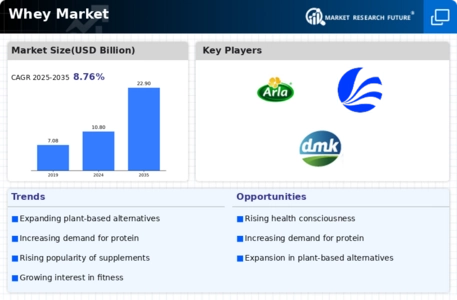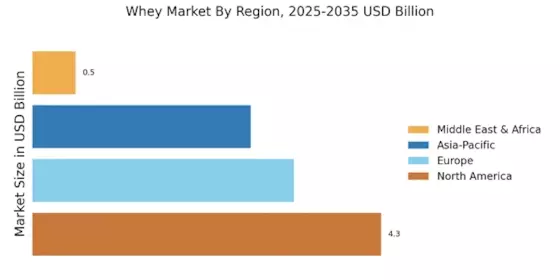Expansion of E-commerce Channels
The Whey Market is experiencing a transformation in distribution channels, particularly with the expansion of e-commerce. Online shopping has become increasingly popular, providing consumers with convenient access to a wide range of whey protein products. This shift is particularly relevant as consumers seek to purchase health and wellness products from the comfort of their homes. Data indicates that e-commerce sales in the health supplement sector are projected to grow significantly, with online platforms becoming a primary source for whey protein purchases. As a result, manufacturers and retailers in the Whey Market are likely to invest in digital marketing strategies and enhance their online presence to capture this growing segment of consumers.
Rising Demand for Protein Supplements
The Whey Market is experiencing a notable increase in demand for protein supplements, driven by a growing awareness of health and fitness. Consumers are increasingly seeking high-protein diets to support muscle growth and recovery, particularly among athletes and fitness enthusiasts. According to recent data, the protein supplement market is projected to reach approximately 20 billion USD by 2026, with whey protein accounting for a substantial share. This trend is further fueled by the rise of fitness culture and the popularity of protein-rich diets, such as ketogenic and paleo diets. As consumers prioritize nutritional value, the Whey Market is likely to expand, with manufacturers innovating to offer diverse formulations that cater to various dietary preferences.
Growing Popularity of Functional Foods
The Whey Market is witnessing a surge in the popularity of functional foods, which are products that offer health benefits beyond basic nutrition. Whey Market protein is increasingly being incorporated into various food products, such as bars, snacks, and beverages, appealing to health-conscious consumers. This trend aligns with the rising demand for convenient, on-the-go nutrition options. Market data suggests that the functional food sector is expected to grow at a compound annual growth rate of over 8% in the coming years. As consumers seek products that support overall health and wellness, the Whey Market is likely to capitalize on this trend by developing innovative functional food offerings that highlight the benefits of whey protein.
Increased Adoption of Plant-Based Diets
While the Whey Market is traditionally associated with dairy-based products, there is a growing trend towards plant-based diets. This shift may seem counterintuitive, yet it presents an opportunity for whey protein to be marketed as a complementary product for those who still consume dairy. The rise of flexitarian diets, where individuals reduce meat and dairy intake while still incorporating some animal products, could bolster the demand for whey protein. Furthermore, the market for plant-based protein is projected to grow significantly, which may lead to innovative product development that combines whey with plant-based ingredients. This trend indicates a potential for the Whey Market to adapt and thrive amidst changing consumer preferences.
Technological Advancements in Production
The Whey Market is benefiting from technological advancements in production processes, which enhance efficiency and product quality. Innovations such as membrane filtration and ultrafiltration techniques allow for the extraction of whey protein with higher purity and better functional properties. These advancements not only improve the nutritional profile of whey products but also reduce production costs, making them more accessible to consumers. As a result, the market is likely to see an influx of high-quality whey protein products that cater to diverse consumer needs. Additionally, the integration of automation and data analytics in manufacturing processes may streamline operations, further propelling the growth of the Whey Market.


















Leave a Comment